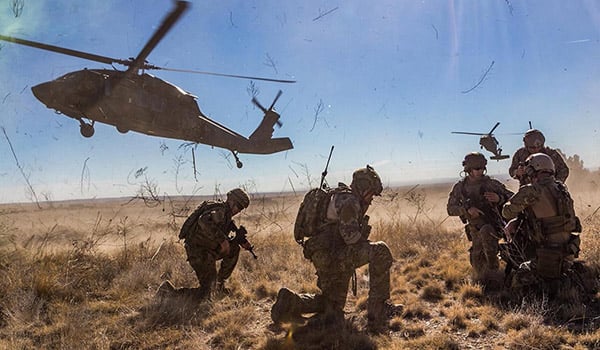
Aviation Branch Chief’s Corner / By MG David J. Francis: The discussion of the future of Army Aviation requires an understanding of where we’re going and how we’re getting there.
Where We’re Going

A tactical air control party from the 13th Air Support Operations Squadron at Fort Carson, Colorado, prepares for helicopter / U.S. ARMY PHOTO BY MSGT. BAUMGARTNER, USAF extraction by the 4th Combat Aviation Brigade.
The 2018 National Defense Strategy (NDS) highlighted Russia and China as our proximate and pacing threats. The requirement to change how we train and fight is the catalyst for the Multi-Domain Operations (MDO) concept and our focus on Large Scale Combat Operations (LSCO) against peer or near-peer adversaries. From this, the Army Modernization strategy was born. The Army has now moved forward significantly with six modernization priorities. Future Vertical Lift (FVL), which is the Army’s #3 priority, contributes to solving the “problem” of standoff, and focuses on fires and movement. Army aviation operates in the third dimension of movement and is the aerial arm of Combined Arms Maneuver (fires + movement), which is the Army’s contribution to the Joint force.
Army aviation is a key component in penetrating the enemy’s Anti Access and Area Denial (A2AD) and Integrated Air Defense Systems (IADS), dis-integrating components of the enemy’s military system, and then exploiting freedom of maneuver necessary to achieve strategic and operational objectives in order to return to competition on terms favorable to the Joint and Coalition force. Within the MDO construct, Army aviation is critical and decisive to survive, fight and win in LSCO. As we partner with industry, the leap-ahead technology being developed will support Army aviation being MDO capable by 2028 and contribute to Army aviation remaining survivable in the high threat, complex environments of LSCO. Additionally, we will make targeted investments in the readiness of our enduring fleets as the AH-64s, UH-60s, and CH-47s will remain in the fight for at least the next 20 years.
How We’re Getting There
This is an extremely exciting and critical time to be a part of Army aviation. Leaders across the Aviation enterprise are now aggressively pursuing a series of solutions to set the conditions to achieve MDO capability by 2028. Discussion to this point focused primarily on platforms, but there’s a lot of work across the DOTMLPF-P (Doctrine, Organization, Training, Materiel, Leader Development, Personnel, Facilities, Policy) to bring new technology into our force. Synchronization for both the Fielded and Future Force is critical to our success.
Doctrine: We’re working diligently on how we fight. Our goal is to rapidly transition concepts to doctrine. This will not happen overnight. However, we learn more every day and leverage the extensive knowledge and experience from across our force. The current MDO concept informs our experiments and exercises, which in turn, will assist us in developing the Aviation doctrine that will drive how we will employ Army Aviation in MDO.
Organization: Leap ahead technology, new platforms, and emerging concepts and doctrine shapes organizational change. This organizational change is occurring through the TAA process. We must strike a balance and optimize the current aviation force to get the maximum capacity out of it, while we simultaneously look to the integration of FVL.
Training: In order to maintain a Combined Arms Maneuver Force, Aviation must remain synchronized with other Centers of Excellence and Cross Functional Teams (CFT) as the Army modernizes. Institutional and home station training will adjust as well as the necessity to expand our training base. Our new technology’s dramatically increased speed and distances will also impact how we train for LSCO across the Army.
Materiel: FVL is a critical capability for the Army and MDO to deliver Combined Arms Maneuver to the Joint force to fight and win in LSCO. FVL embraces and pursues the priorities of Reach, Protection, Lethality, and Sustainment. Senior Army leaders are engaged continuously in the process of developing and acquiring these technologies. We are funded and on-track to bring FVL on-line.
Leader Development and Education: This is my top priority as the Chief of the Aviation Branch. Growing leaders that will operate via mission command in dispersed formations across great distances while fighting and winning is critical to the future of our Army. We’re relooking the professional career development models as one effort to improve effectiveness of our leaders. To put it in perspective, today’s lieutenants will be combat aviation brigade (CAB) S3s and XOs in 2028 and battalion commanders in 2035. Our current sergeants will be platoon sergeants and command sergeants major when Aviation is MDO capable and ready, and our newest warrant officers will be seasoned standardization pilots, aviation mission survivability officers, maintenance test pilots and safety officers at that time. We must get leader development right… now!
Personnel: FVL will require new military occupational specialties (MOS) to fix, operate and employ the platforms and capabilities. Whether current MOSs expand, or if new MOSs are created, we will still recruit, train, and fight with our most valued assets – our Soldiers.
Facilities: The Future Force will operate and train differently with new materiel. Current facilities will most likely require adjustments to house our FVL platforms. The introduction of long range fires, increased speeds and ranges, air launched effects, and teaming of manned and unmanned systems will also dictate changes to the facilities at which we currently train these capabilities.
Policy: AR 95-1, along with other policy documents, require revision due to new capabilities. Army policies must account for training and employing new systems in training areas and national airspace in order to leverage the full capabilities of our new technologies.
The entire Aviation enterprise is at full speed to set the conditions to achieve MDO 2028 capability. I’m proud of the results we’ve made so far, and I challenge each leader out there to continue pressing forward.
Above the Best!
MG David J. Francis is the Army Aviation branch chief and commander of the U.S. Army Aviation Center of Excellence and Fort Rucker, AL.
























